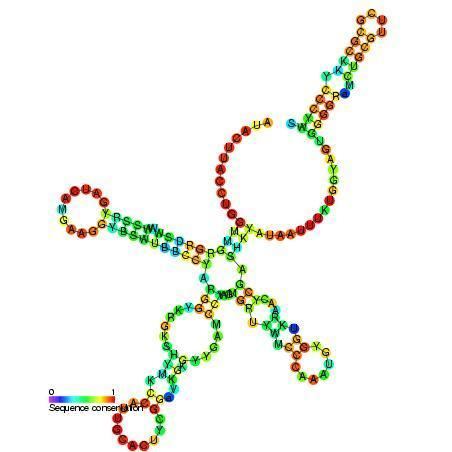Symbol U1 SO 0000391 | Rfam RF00003 Domain(s) Eukaryota | |
 | ||
GO 0000368 0030627 0005685 | ||
U1 spliceosomal RNA is the small nuclear RNA (snRNA) component of U1 snRNP (small nuclear ribonucleoprotein), an RNA-protein complex that combines with other snRNPs, unmodified pre-mRNA, and various other proteins to assemble a spliceosome, a large RNA-protein molecular complex upon which splicing of pre-mRNA occurs. Splicing, or the removal of introns, is a major aspect of post-transcriptional modification, and takes place only in the nucleus of eukaryotes.
Structure and function
In humans, the U1 spliceosomal RNA is 164 bases long, forms four stem-loops, and possesses a 5'-trimethylguanosine five-prime cap. Bases 3 to 10 are a conserved sequence that base-pairs with the 5' splice site of introns during RNA splicing, and bases 126 to 133 form the Sm site, around which the Sm ring is assembled. Stem-loop I binds to the U1-70K protein, stem-loop II binds to the U1 A protein, stem-loops III and IV bind to the core RNP domain, a heteroheptameric Sm ring consisting of SmB/B', SmD1/2/3, SmE, SmF, and SmG. U1 C interacts primarily through protein-protein interactions.
Experimentation has demonstrated that the binding of U1 snRNA to the 5'-splice site is necessary, but not sufficient, to begin spliceosome assembly.
There are significant differences in sequence and secondary structure between metazoan and yeast U1 snRNAs, the latter being much longer (568 nucleotides as compared to 164 nucleotides in humans). Nevertheless, secondary structure predictions suggest that all U1 snRNAs share a 'common core' consisting of helices I, II, the proximal region of III, and IV. This family does not contain the larger yeast sequences.
A non-canonical role for U1 snRNP has recently been described in the regulation of alternative polyA site selection It is proposed that increased transcription rates "sponge" U1 snRNP, decreasing its availability. This model is supported experimentally, as reducing U1 snRNP levels with antisense morpholino oligonucleotides led to a dose-dependent shift of polyA usage to generate shorter mRNA transcripts.
